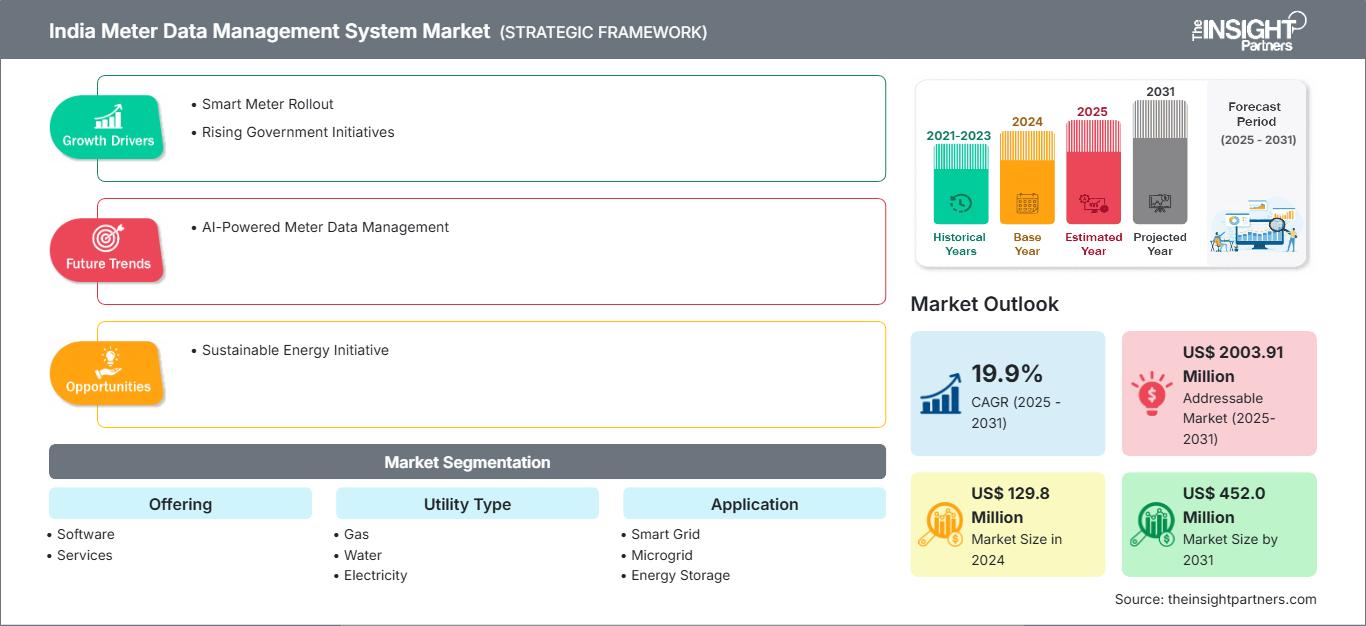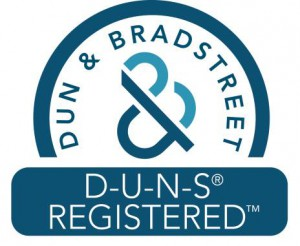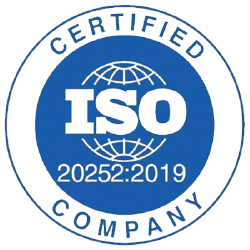인도 미터 데이터 관리 시스템 시장 규모는 2024년 1억 2,980만 달러에서 2031년 4억 5,200만 달러로 성장할 것으로 예상됩니다. 이 시장은 2025년부터 2031년까지 19.9%의 CAGR을 기록할 것으로 예상됩니다.
인도 미터 데이터 관리 시스템 시장 분석
인도 계량기 데이터 관리 시스템 시장은 향후 몇 년간 상당한 성장세를 보일 것으로 예상됩니다. 강력한 정부 정책과 의무적인 스마트 미터 도입으로 인해, 특히 클라우드, AI, IoT, 그리고 다중 유틸리티 통합을 제공하는 강력한 계량기 데이터 관리 플랫폼에 대한 수요가 증가할 것으로 예상됩니다. 비용, 상호운용성, 그리고 용량 문제로 인한 지속적인 제약 속에서도 인도는 디지털화되고 효율적인 전력 생태계로 전환함에 따라 글로벌 및 국내 소프트웨어, 서비스, 그리고 시스템 통합 공급업체들에게 지속적인 기회를 제공합니다. 인도의 스마트 미터링 전환은 전력 배전 부문 현대화에 있어 중추적인 진전을 의미합니다.
정부의 적극적인 지원과 체계적인 재정 지원 메커니즘을 통해 이러한 이니셔티브는 운영 효율성을 높이고 손실을 줄이며 소비자 경험을 개선할 것으로 기대됩니다. 스마트 미터에서 유입되는 방대한 데이터를 수집, 검증 및 관리하는 디지털 백본 역할을 하는 미터 데이터 관리 시스템(DMMS) 도입 증가는 이러한 혁신의 초석을 형성합니다.
인도 미터 데이터 관리 시스템 시장 개요
인도 계량기 데이터 관리 시스템(EDR)은 사이버 보안 솔루션으로, 전력, 가스, 수도, 열 에너지 분야의 공공 서비스 제공업체에 필수적인 모니터링, 탐지 및 관리를 지원합니다. 이 시스템을 통해 고객 사업장의 계량기 사용 데이터를 수집, 검증 및 관리할 수 있습니다. 이 데이터에서 얻은 정보는 청구, 고객 서비스, 소비 예측, 운영 모니터링(정전 감지 및 손실 분석 등), 재무 보고 등 다양한 기능을 지원합니다. 공공 서비스 외에도 에너지 서비스 회사는 감사 및 에너지 효율 개선을 위해, 에너지 관리 회사는 사용량 보고 및 분석을 위해, 독립 및 지역 에너지 공급업체는 생산 계획 및 엔지니어링을 위해, 그리고 상업 및 산업 기업은 내부 회계 및 재무 관리를 위해 계량기 데이터 관리 시스템을 도입하고 있습니다. 지자체와 정부 기관 또한 공공 인프라 구축 및 규정 준수를 위해 이러한 시스템을 활용하고 있습니다.
이 보고서의 일부 또는 국가 수준 분석, Excel 데이터 팩을 포함하여 모든 보고서에 대한 사용자 정의를 무료로 받을 수 있으며, 신생 기업 및 대학을 위한 훌륭한 혜택과 할인도 이용할 수 있습니다.
인도 계량기 데이터 관리 시스템 시장: 전략적 통찰력

- 이 보고서에서 주요 시장 동향을 알아보세요.이 무료 샘플에는 시장 동향부터 추정치 및 예측까지 다양한 데이터 분석이 포함됩니다.
인도 계량기 데이터 관리 시스템 시장 동인 및 기회
시장 동인:
스마트 미터 출시:Rollout:
인도는 전 세계적으로 가장 야심찬 스마트 미터 도입 계획 중 하나를 통해 에너지 부문을 빠르게 발전시키고 있으며, 디지털 유틸리티 혁신의 선두에 서 있습니다. 아베너 캐피털(Avener Capital)의 보고서에 따르면, 인도 정부는 2억 5천만 대의 스마트 미터를 설치할 계획이며, 이를 통해 200억 달러 규모의 시장 기회가 창출될 것으로 예상됩니다.rollout initiatives globally, positioning itself at the forefront of digital utility transformation. The government plans to install 250 million smart meters, in a move projected to unlock a US$20 billion market opportunity, according to the report by Avener Capital.증가하는 정부 이니셔티브:Initiaitves:
인도 계량기 데이터 관리 시스템(DMMS) 시장 성장을 견인하는 주요 요인 중 하나는 정부가 야심찬 정책 추진과 집중적인 투자를 통해 배전 부문 현대화에 더욱 집중하고 있다는 점입니다. 2022년 7월, 인도 총리는 전력부(Ministry of Power)의 주력 사업인 배전 부문 개혁 계획(RDSS)을 출범시켰는데, 이는 배전 회사(DISCOM)의 운영 효율성과 재정적 지속가능성 향상을 목표로 합니다.RDSS), aimed at enhancing the operational efficiency and financial sustainability of power distribution companies (DISCOMs).
시장 기회:
지속 가능한 에너지 이니셔티브:
인도는 최근 몇 년간 에너지 부문 강화에 있어 괄목할 만한 진전을 이루며, 빠르게 증가하는 전력 수요 충족과 지속가능성 목표 달성이라는 중요한 두 가지 목표를 효과적으로 균형 있게 달성해 왔습니다. 세계에서 가장 빠르게 성장하는 경제 대국 중 하나인 인도는 세계 에너지 전환의 선두에 서 있으며, 주요 경제국 중 가장 빠른 속도로 에너지 소비가 증가할 것으로 예상됩니다. 2025년 2월, 국제에너지기구(IEA)는 신흥국과 개발도상국이 2026년부터 2029년까지 전 세계 전력 수요 증가의 85%를 차지할 것이며, 인도는 이러한 역동적인 환경에서 핵심적인 역할을 수행할 것이라고 전망했습니다. 전 세계 1차 에너지 소비에서 인도가 차지하는 비중은 2035년까지 두 배로 증가할 것으로 예상되며, 이는 세계 에너지 시장에서 인도의 영향력 확대를 보여줍니다.
인도 계량기 데이터 관리 시스템 시장 보고서 세분화 분석
인도 계량기 데이터 관리 시스템 시장은 작동 방식, 성장 잠재력, 그리고 최신 동향을 더욱 명확하게 보여주기 위해 여러 부문으로 구분됩니다. 대부분의 업계 보고서에서 사용되는 표준 세분화 방식은 다음과 같습니다.
제공을 통해:
소프트웨어:
미터 데이터 관리 시스템의 소프트웨어 구성 요소는 스마트 유틸리티가 스마트 미터에서 생성되는 방대한 양의 데이터를 수집, 저장, 처리 및 분석할 수 있도록 하는 기술적 핵심입니다.서비스:
계량기 데이터 관리 시스템 관련 서비스는 성공적인 구축 및 수명 주기 관리를 위해 필요한 다양한 서비스를 포함합니다. 여기에는 요구 사항 분석, 컨설팅, 아키텍처 설계와 같은 구축 전 활동과 시스템 통합, 테스트 및 구축이 포함됩니다.
유틸리티 유형별:
전기:
전기 회사는 주로 스마트 전기 계량기 의 대량 출시로 인해 계량기 데이터 관리 시스템 시장을 장악하고 있습니다.물:
계량기 데이터 관리 시스템의 수도 사업 부문은 공공 서비스 제공업체가 노후화된 인프라를 현대화하고 물 부족, 누수, 무수익 물(NRW)과 같은 시급한 과제를 해결하고자 함에 따라 성장을 경험하고 있습니다.가스:
가스 공급 사업체에서 계량기 데이터 관리 시스템은 안전, 청구 정확성, 그리고 규정 준수에 도움을 줍니다. 스마트 가스 계량기는 시스템 무결성과 효율적인 운영에 필수적인 소비량 데이터, 유량, 그리고 압력 수준을 제공합니다.
응용 프로그램별:
스마트 그리드:
스마트 그리드 애플리케이션 부문은 미터 데이터 관리 시스템의 가장 기본적이고 성숙한 사용 사례입니다.마이크로그리드:
미크로그리드는 1차 전력망과 독립적으로 또는 연계하여 운영되는 지역화된 전력망입니다.에너지 저장:
미터 데이터 관리 시스템은 배터리 충전/방전 주기, 에너지 처리량, 건강 상태(SoH) 및 그리드 신호 통합을 정확하게 추적하는 데 도움이 됩니다.EV 충전:
전기 자동차(EV) 충전은 전력망 운영자에게 새로운 과제와 기회를 제공합니다.기타:
건물 에너지 관리 , 지역 난방, P2P 에너지 거래, 에너지 효율 프로그램 등의 분야에서 미터 데이터 관리 시스템의 다른 응용 분야가 등장하고 있습니다 .
최종 사용자 산업별:
- 주거용
- 상업적
- 산업
각 부문에는 구체적인 계량기 데이터 관리 시스템 요구 사항이 있으며, 이는 데이터 관리 및 분석에 영향을 미칩니다.
인도 미터 데이터 관리 시스템 시장 지역별 통찰력
The Insight Partners의 분석가들은 예측 기간 동안 인도 계량기 데이터 관리 시스템 시장에 영향을 미치는 지역별 동향과 요인을 면밀히 분석했습니다. 이 섹션에서는 북미, 유럽, 아시아 태평양, 중동 및 아프리카, 중남미 지역의 인도 계량기 데이터 관리 시스템 시장 부문 및 지역별 현황도 살펴봅니다.
인도 미터 데이터 관리 시스템 시장 보고서 범위
| 보고서 속성 | 세부 |
|---|---|
| 2024년 시장 규모 | 1억 2,980만 달러 |
| 2031년까지 시장 규모 | 4억 5,200만 달러 |
| 글로벌 CAGR(2025~2031년) | 19.9% |
| 역사적 데이터 | 2021-2023 |
| 예측 기간 | 2025-2031 |
| 다루는 세그먼트 | 제공함으로써
|
| 포함된 지역 및 국가 | 인도
|
| 시장 선도 기업 및 주요 회사 프로필 |
|
인도 계량기 데이터 관리 시스템 시장 참여자 밀도: 비즈니스 역학에 미치는 영향 이해
인도 계량기 데이터 관리 시스템 시장은 소비자 선호도 변화, 기술 발전, 그리고 제품 이점에 대한 인식 제고 등의 요인으로 인한 최종 사용자 수요 증가에 힘입어 빠르게 성장하고 있습니다. 수요 증가에 따라 기업들은 제품 및 서비스 확장, 소비자 니즈 충족을 위한 혁신, 그리고 새로운 트렌드를 적극 활용하며 시장 성장을 더욱 가속화하고 있습니다.

- 인도 미터 데이터 관리 시스템 시장 주요 주요 업체 개요를 확인하세요.
인도 미터 데이터 관리 시스템 시장 점유율 분석
스마트 미터 도입과 정부 정책의 강화는 인도 계량기 데이터 관리 시스템 시장을 이끄는 주요 요인입니다. 지속 가능한 에너지 정책으로 인해 예측 기간 동안 시장은 계속 성장할 것으로 예상됩니다. AI 기반 계량기 데이터 관리의 증가는 시장의 주요 트렌드 중 하나입니다. 그러나 일관성 없는 계량 데이터는 시장 성장을 저해할 수 있습니다.
1. 인도
시장 점유율:
글로벌 시장의 상당 부분을 차지합니다주요 동인:
- 스마트 미터 출시:
- 증가하는 정부 주도의 이니셔티브.
트렌드:
AI 기반 미터 데이터 관리 시스템.
인도 계량기 데이터 관리 시스템 시장 참여자 밀도: 비즈니스 역학에 미치는 영향 이해
높은 시장 밀도와 경쟁
Siemens AG, Landis + GYR Group AG, Itron과 같은 기존 업체들의 존재로 인해 경쟁이 치열합니다. FluentGrid(인도)와 Genus(인도)와 같은 지역 및 틈새 시장 업체들도 전국적인 경쟁 구도를 더욱 심화시키고 있습니다.
이러한 높은 수준의 경쟁으로 인해 기업은 다음과 같은 서비스를 제공하여 두각을 나타내야 합니다.
- 고급 보안 기능
- 분석 및 미터 데이터 관리와 같은 부가가치 서비스
- 경쟁력 있는 가격 모델
- 강력한 고객 지원 및 쉬운 통합
기회와 전략적 움직임
- 스마트 그리드, IoT 및 분석과의 통합.
- 표준화 및 상호 운용성에 중점을 둡니다.
인도 미터 데이터 관리 시스템 시장에서 운영되는 주요 회사는 다음과 같습니다.
- 아이트론 주식회사(미국)
- 오라클 주식회사(미국)
- 젠트랙 그룹(뉴질랜드)
- Fluentgrid Limited(인도)
- 지멘스 AG(독일)
- EnergiSpeak(인도)
- BCITS(인도)
- Esyasoft(인도)
- Landis+Gyr Group AG(스위스)
- Genus Power Infrastructures Ltd.(인도)
면책 조항: 위에 나열된 회사는 특정 순서에 따라 순위가 매겨지지 않았습니다.
연구 과정에서 분석된 다른 회사:
- 쿠쿨루스 조노스
- 스마트플렉스
- 코넥소 인사이트
- ATLAS 에너지 모니터링 시스템
- PI 시스템(AVEVA)
- Net@Suite(엔지니어링 Ingegneria Informatica)
- 테라노바 TAMM MDM
- 페란티 MECOMS
- 에너지웍스
- 수액
- 메디데이터 솔루션
- 라딕스 IoT
- 에너지캡
- 허니웰 EI서버
- 이튼
인도 미터 데이터 관리 시스템 시장 뉴스 및 최근 동향
Esyasoft는 Adani Energy와 합작 투자를 했다고 발표했습니다.
Esyasoft는 인도 및 기타 국가에서 스마트 계량 프로젝트를 시행하기 위해 Adani Energy Solutions와 합작법인을 설립했다고 발표했습니다. 이 파트너십을 통해 Adani는 Esyasoft의 스마트 계량 솔루션 부문 지분 49%를 인수하게 됩니다.Landis+Gyr은 MDUS 인증을 완료했다고 발표했습니다.
Landis+Gyr은 Landis+Gyr MDMS 플랫폼에 대한 MDUS 인증을 완료했다고 발표했습니다. 이 인증을 갱신함으로써 MDUS 통합 서비스를 사용하는 공공 서비스 고객은 간격 및 시계열 청구를 위한 새로운 기능을 이용할 수 있게 되었습니다. Landis+Gyr의 MDUS(Meter Data Unification and Synchronization)는 스마트 미터링 환경을 공공 서비스 백오피스 시스템에 연결하고 동기화하여 엔드 투 엔드 비즈니스 프로세스를 지원하는 독보적인 솔루션입니다.
인도 미터 데이터 관리 시스템 시장 보고서 범위 및 제공 내용
"인도 미터 데이터 관리 시스템 시장 규모 및 예측(2021~2031)" 보고서는 아래 영역을 포괄하여 시장에 대한 자세한 분석을 제공합니다.
- 범위에 포함된 모든 주요 시장 부문에 대한 국가 수준의 인도 미터 데이터 관리 시스템 시장 규모 및 예측
- 인도 미터 데이터 관리 시스템 시장 동향 및 드라이버, 제약 및 주요 기회와 같은 시장 역학
- 자세한 PEST 및 SWOT 분석
- 주요 시장 동향, 글로벌 및 지역 프레임워크, 주요 참여자, 규정 및 최근 시장 개발을 다루는 인도 미터 데이터 관리 시스템 시장 분석
- 인도 미터 데이터 관리 시스템 시장의 시장 집중도, 히트맵 분석, 주요 업체 및 최근 개발 사항을 다루는 산업 환경 및 경쟁 분석
- 자세한 회사 프로필
- 과거 분석(2년), 기준 연도, CAGR을 포함한 예측(7년)
- PEST 및 SWOT 분석
- 시장 규모 가치/거래량 - 글로벌, 지역, 국가
- 산업 및 경쟁 환경
- Excel 데이터세트
최근 보고서
사용 후기
구매 이유
- 정보에 기반한 의사 결정
- 시장 역학 이해
- 경쟁 분석
- 고객 인사이트
- 시장 예측
- 위험 완화
- 전략 기획
- 투자 타당성 분석
- 신흥 시장 파악
- 마케팅 전략 강화
- 운영 효율성 향상
- 규제 동향에 발맞춰 대응




















 무료 샘플 받기 - 인도 미터 데이터 관리 시스템 시장
무료 샘플 받기 - 인도 미터 데이터 관리 시스템 시장